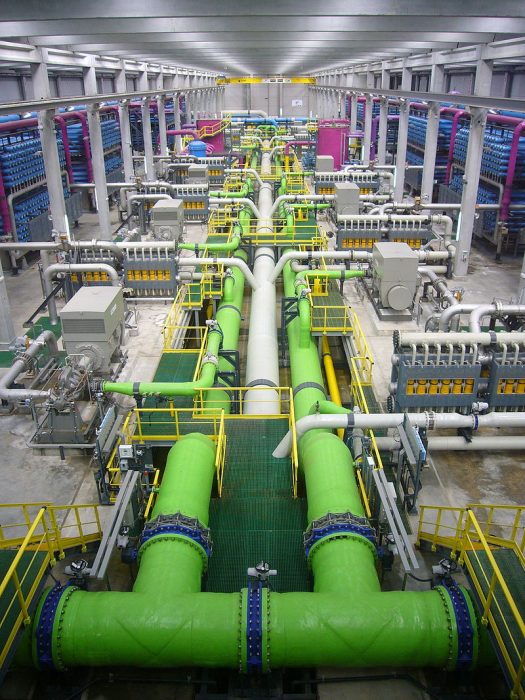
Researchers at Indiana University have recently engineered a molecule with the potential to noticeably boost the amount of clean drinking water on the planet. The powerful new molecule essentially functions as a cage to trap salt, removing the salt from the water and making it drinkable.
The Need For Clean Water
The process of removing salt from water is referred to as desalination. Desalination is becoming more necessary as the human population continues to grow. Many freshwater systems in the world are seeing salt seep into them, which reduces the amount of fresh water available.
According to EuropeNow, The US Geological Survey (USGS) recently estimated that around 270 metric tons of salts and other dissolved solids seep into freshwater streams over the course of an average year. These solids come from various sources. The use of water softeners and road salts is a contributor to salt seepage, as is the chemical treatments of soil involved in oil extraction. Natural sources of salts and other solids include the weathering of rock. Five gallons of water can be polluted by only 1 teaspoon of salt.

A water desalination plant in Barcelona, Spain. Photo: By James Grellier – Own work, CC BY-SA 3.0 https://creativecommons.org/licenses/by/2.5/, https://commons.wikimedia.org/w/index.php?curid=11038652
The goal of removing dissolved solids from water is typically done with two different methods: thermally driven desalination and barrier desalination. Thermally driven desalination methods remove solids, like salts, from the water by boiling or vaporizing the water, leaving the salt behind, as it isn’t volatile. The other method for desalinating water is a barrier method, which involves using selective membranes (filters) to separate out solids from water. Nanofiltration and reverse osmosis methods both use filters that allow water to selectively pass through them and leave salt behind.
As climate change exacerbates current stresses on water resources throughout the world, nations across the globe are creating plans to deal with droughts. South Africa and South Asia, in particular, are predicted to be extremely vulnerable to climate change-related food shortages caused by lack of water. According to the council for European studies, access to clean drinking water is projected to be a major challenge in the 21st century, and in the US alone water shortages could affect up to forty US states over the next decade.
Organizations like the US National Academy of Engineering and the National Alliance for Water Innovation (NAWI) are responding to the increasing water demand by promoting projects that will create advances in desalination technology (along with other water treatment/saving systems). The US Department of Energy has recently established the Energy-Water Desalination Hub, whose goal is to fund projects much like the Indiana University project which succeeded in creating a new salt-trapping molecule.
The Salt-Trapping Molecule
The report from the researchers at Indiana University was recently published in the journal Science, and as covered by ScienceDaily, it details the structure of the molecule the researcher’s created. While the chemical bonds used to create the molecule were once thought to be too weak, the bonds comprising the molecule are approximately 10 billion times more powerful than a similar version of the molecule created over a decade ago at Indiana University.

Image of salt crystals. Photo: By The original uploader was W.J.Pilsak at German Wikipedia. – Transferred from de.wikipedia to Commons., CC BY-SA 3.0, https://creativecommons.org/licenses/by/2.5/ https://commons.wikimedia.org/w/index.php?curid=1391260
Ph.D. student Yun Liu led the study. Liu works in the Amar Flood lab, and Flood is the James F. Jackson Professor of Chemistry and Luther Dana Waterman Professor in IU’s Department of Chemistry. Liu explains that if one were to take 1 millionth of a gram of the engineered molecule and inject it into approximately a metric ton of water, all of the molecules would still be able to capture salt.
The molecule created by the researchers is intended to bind with chloride, which originates when atoms of chlorine bond with other elements and gain electrons. One of the most notable chloride salts is sodium chloride, a.k.a. table salt. Potassium chloride, ammonium chloride, and calcium chloride are all other well-known chlorides.

An example of a triazole structure. Photo: By Jü – Own work, CC BY-SA 3.0 https://creativecommons.org/licenses/by/2.5/, https://commons.wikimedia.org/w/index.php?curid=31469449
The Indiana University research team created the salt extraction molecule with a combination of nitrogen, carbon, and hydrogen atoms arrayed in five-membered rings called triazoles. Six of these triazoles were used to comprise the molecule, and when these structures are joined together they form a three-dimensional cage that is capable of containing chloride.
As the New Zealand Herald explains, the new molecule is based on a similar, two-dimensional molecule, created by Flood’s lab in 2008. This earlier molecule was comprised of four triazoles, and the two new triazoles introduced by the team give it its 3-D shape. The resulting structure boosts its efficiency by almost 10 billion times.
The rigid nature of the structure even allows the molecule to retain the general shape of the structure after the central chloride has dissipated. Previous attempts to create chemical cages found that the cage structures usually collapsed because of their flexibility, but the current cage model is much more versatile and effective.
One notable aspect of the engineered molecule is that it is comprised of carbon-hydrogen bonds, which many scientists regarded as too unstable and weak to produce useful interactions with chloride. Traditionally, structures that used a nitrogen-hydrogen bond were preferred for chloride interactions. However, the arraying of triazoles in the cage formation forms an extremely rigid and stable structure. In fact, the structure is so rigid that a vacuum is essentially created in the center of the structure, and this vacuum is what pulls chloride ions into the molecule.
A similar technique has been used to create cages out of nitrogen-hydrogen bonds, but these structures are usually much more flexible and inefficient compared it to the new molecule. The vacuum at the center of the nitrogen-hydrogen bond cage required energy input to capture chlorides, in contrast to the triazole structure.
Amar Flood explains that when compared to other molecular cages that employ stronger bonds, the triazole molecule has a performance that is several orders of magnitude better, and that rigidity is severely “underappreciated in the design of molecular cages”.
Liu explains that the original molecule took approximately a year to synthesize and that the crystals necessary to determine the molecular structure had formed after the experiment had been placed in storage for some number of months. Upon examining the formation of the crystals, Liu realized that the unique structure of the molecule was viable and could be reproduced. Another postdoctoral researcher in the same lab was able to re-create the molecular structure several months later.
Chun-Hsing “Josh” Chen Worked in the IU Molecular Structure Center when the study was conducted. Chen was responsible for confirming the structure of the molecule with the assistance of x-ray crystallography.
Other Desalination Advances
The research conducted at Indiana University was not the only recent advancement in desalination technology. Researchers from the Kinneret Academic College in Israel have reportedly developed a method of reducing the cost of desalination by combating “biofouling”, according to XinhuaNet. Biofouling refers to a phenomenon where bacteria grow on the desalination membranes and reduce the efficiency of the seawater desalination process.
Israel has recently had to contend with many droughts and growing demand for clean water to use in homes, industry, and agriculture. The country, in general, is preparing to combat long periods of drought by investing in desalination technologies. Construction is set to begin in 2020 on Israel’s largest desalination plant, and by the year 2023 Israel will be drawing approximately 85% of its potable water from the sea. This need drove the research team at Kinneret to develop methods to reduce biofouling.

Photo: By אילנה שקולניק ilana shkolnik, CC BY 2.5 https://creativecommons.org/licenses/by/2.5/, https://commons.wikimedia.org/w/index.php?curid=6189502
The Israeli researchers created organic molecules that bind themselves to the membranes of the filters, and in doing so the filters gain anti-microbial properties that discourage the growth of bacteria. The molecules in question are a type of conductive polymer made out of polyaniline. The polymer is grafted to the filter membranes. When the polyaniline was applied to the filters, there was a substantial reduction in biofouling. The head of the research team at Kinneret, Ran Suckeveriene, says that the new polymer could potentially double the working life of filter membranes in desalination plants.
Other countries around the world are also investing in desalination technologies. As reported by FastCompany, the country of Namibia is making use of a solar power based desalination device. The devices, developed by Solar Water Solutions (based out of Finland) uses solar power to drive reverse osmosis, which separates salt from the water. Reverse osmosis mandates that water be kept at constant pressure, and the device is able to accomplish this by using the solar power it harnesses. The device is able to keep water at the correct pressure without needing connections to the grid or the large, expensive battery storage units. The estimated output of the solar-powered desalination device is around 3500 L of water an hour.








